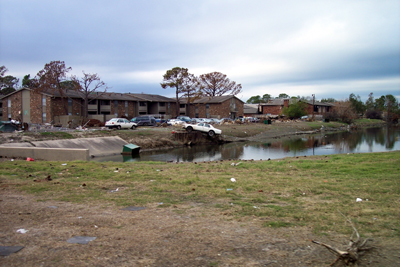
New Orleans East
New Orleans: The City
That America Forgot(continued)
By Lance Cutler
Then she heard Bill cry out. She went into the bedroom, and there on the bed were Bill's guitars: all five of them in perfect condition, just as he had left them. No mud, no water damage, no breakage. They held each other. They collected what they could salvage, and they loaded it into the car. Then they prayed and headed back to Houston.
They headed back to their daughter Sofia and the rest of Kim's family, all of whom had been born and raised in New Orleans. They went back to her sisters Tracie and Nikki, her brother Ed, her brother-in-law Jamel, her 94-year-old grandmother Miss Dora, her mother Lorraine and her father, Reverend Edmond Prevost, founder and minister of the First Thessolonian Baptist Church at 840 Caffin Street in New Orleans' Ninth Ward.
If you left Slidell and returned to New Orleans on the Twin Spans of Interstate 10 (except that only one of the Twin Spans remained) you'd pass back through the desolate New Orleans East. Then head left toward the river for 31 miles of misery and darkened houses, and you'll get to what's left of Reverend Prevost's church. The First Thessolonian Baptist Church was one of many churches in the neighborhood, and had served the community for 26 years. Kim remembers the fundraising dinners of her childhood, where the church ladies would fry fish or fry chicken and charge nominal sums to raise money for the less fortunate members of the church. No more. There's no church. There's no minister. There are no church ladies. If there's any chicken, it's rotting in some abandoned refrigerator. If there's any fish, it's drying up in the cracked mud that covers the streets and the lawns and the living rooms of the remaining houses.
The Ninth Ward was a tight-knit community, full of people who had lived their entire lives in New Orleans. Seventy percent of the residents owned their own homes. Mostly black, this was the real heart and soul of New Orleans. Now those homes are empty. All of them are empty. They are empty except for the flies. Tiny, humpbacked coffin flies are all over the place, thousands of them, millions of them. They are most active after butyric fermentation has begun and when corpses are starting to dry. Coffin flies can dig their way through cracks in the soil to get to buried coffins. In the Ninth Ward, they needn't bother. Some of the bodies are still lying out in the open, three months after Katrina.
If you head down Caffin Street and turn left onto St. Claude, go over the Industrial Canal that breached and caused so much of the flooding, and turn left to 1038 Pauline St, you'll be at Charmaine Neville's house in the Bywater district. It's 1.6 miles as a coffin fly flies. Charmaine chose to stay in New Orleans during the hurricane, and at the time of the mandatory evacuation she was caring for a neighbor and couldn't get out. She spent days without food or water, stayed on the roof of a nearby school, was raped by looting gangs, and finally commandeered a city bus and made her way towards Baton Rouge with 23 of her neighbors. Charmaine is a hero, and a musician, and a native of New Orleans.
Charmaine compared her return home to an old black and white Vincent Price horror film. The view from the 610 freeway was sheer desolation. There were no trees, no grass, nothing green. Just mud and emptiness. There were no sounds. No birds, no dogs, no cats, just the dying beeps of smoke detectors.
She came around a corner and saw that her house was still standing. She wept. Mud and gunk were everywhere and bugs and dead fish and the damn flies. Inside, her house was coated with gooey mud. White fuzzy mold grew up the walls, purple dry mold climbed the ceiling and green slimy mold dotted the curtains. Upstairs, where the windows had blown out, everything was wet. The ceiling was caving in, the walls were damp and moldy, and the furniture ruined, but at least there was no mud. There was a tree in her laundry room. Her fence was gone, but there was no mud upstairs.
Charmaine mourned for her Bywater neighborhood, for the two nearby public schools, for the seven churches within five blocks, for the small grocery markets that seemed to be on every corner. She missed her totally mixed neighborhood with its mansions along the river and its simple houses, and even the stark poverty across St. Claude Avenue. She yearned for her neighborhood of rich and poor, black and white, Asian and Hispanic, the neighborhood that was New Orleans.
Charmaine left her house that day, the house in which she had lived for 21 years, and went on the road. She sang in Portland, Oregon, in Washington, D.C., in Atlanta, Georgia, and wherever she sang she told the people in her audience, the New Orleans people, that they had to return home. They had to rebuild their city.
She's back in New Orleans now, where she plans to fix her house and
then fix her neighborhood. "We need to have the young people back.
We need them to continue the culture; otherwise we'll lose this wonderful,
special culture to others. Those other people will rewrite history and
claim it for themselves and in doing so they will ruin it."